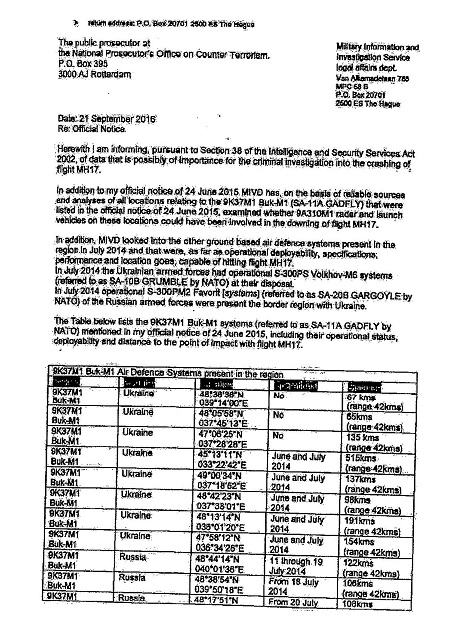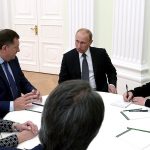As the trial date on MH17 case approaches, the activity of pro-Russian disinformation groups is going to increase. But no amount of disinformation can negate the fact that both the Netherlands and Australia hold Russia responsible for the deployment of a BUK missile system that was used to down the Malaysian airliner and take almost 300 lives.
Bonanza platform, created by the Kremlin to doctor up the investigation of Malaysia Airlines Flight 17 (MH-17) crash, shot down by the Russian BUK-M1 anti-aircraft missile system, released intelligence data from the Netherlands that confirm the JIT and the Bellingcat investigation results.
The released issue is a response from the intelligence service of the Kingdom of the Netherlands to the request of the Dutch prosecutor’s office to provide data that may be important for the criminal investigation. The document is dated 2016.
The document lists 11 locations of Ukrainian and Russian BUK air defense systems indicating the dates when these locations were discovered by Dutch intelligence. According to the paper, BUK air defense system of the Ukrainian air defense forces covered military units in the Kharkov region and the airfield in Kramatorsk. On the Russian side, BUKs’ positions were set up in the Millerovo district of the Rostov Oblast. This location corresponds to the Bellingcat investigation, where this position is indicated as the base for the Russian 53rd anti-aircraft missile brigade that, according to JIT, included the system that shot down the Boeing.


The intelligence response claims that Ukrainian and Russian positions were at a distance of more than 40 kilometers (the BUK missile’s range) from MH-17 crash site. This means the missile that shot down the Boeing could not be launched by any of them.
The paper does not contain statements on the particular air defense system that shot down the plane. However, having cited the data indicating the positions of the air defense systems, the Netherlands intelligence emphasized that, due to the nature of the conflict and the position of the fronts, in July 2014 the Ukrainian BUK missile system most likely could not be transferred from one of the identified positions so as to be in the right radius from where the missile hit the Boeing. Dutch intelligence does not make a similar conclusion about Russian BUKs.

Therefore, this document does not refute the conclusions made by the JIT. On the contrary, if Russia could not have shot down MH17 from its base (at Millerovo, at that time), therefore it sent the BUK overnight across the border and on to Snizhne and extricated it asap after the shoot-down.
The released paper indicates that Russia has gained access to the case files. That might be a result of hacking during the Russian military intelligence operation in The Hague in 2018, or the investigation records could have been handed over to people collaborating with Russia, for example, Max van der Werff from Bonanza. The fact that Russia has got access to the investigation records is unlikely to change the course of the hearings but may affect the sentence for individual defendants in the trial scheduled for March 2020 in The Hague. However, this leak should be a signal for the Dutch counterintelligence agencies.
The Kremlin’s main tactics is to question the evidence collected by the JIT and to fabricate alternative investigative leads shifting responsibility, in particular, onto Ukraine.
Bonanza is a group of two persons. One of them is Russian citizen Yana Yerlashova, an ex-correspondent for Russia Today, a propaganda TV channel, repeatedly accused of participating in smear and influence campaigns in the US, Europe and the Middle East. For the last several years, Yerlashova has been working for RT Documentary, an RT unit producing propaganda documentaries. She claimed to have left RT “not to have any labels”.

Yana Yerlashova 
Max Ven Der Werff
In 2019, she created Bonanza Media online platform. The main purpose of the platform is to disseminate information that refutes the official lead of MH-17 Malaysian Airlines flight crash investigation and to spread the Russian version of this disaster. The whole scope of information disseminated through the platform’s web resources is devoted to covering this issue.
Yerlashova works in cooperation with a Dutch citizen, journalist Max van der Werff, born January 31, 1963 in Arnhem, The Netherlands. Following MH-17 flight crash, he made considerable efforts to spread the version that Russia was not involved in the crash of the Malaysian aircraft. In 2016, Van der Werff, along with other pro-Russian European journalists and experts, signed a letter to US President D. Trump demanding to review the results of MH-17 crash formal investigation.
Van der Werff authored “MH-17, A Call for Justice,” documentary, produced by Yerlashova. The film features 1983 Soviet propaganda style, when a Soviet fighter crashed a Korean civil aircraft. The documentary was produced in close cooperation with the command of the so-called unrecognized DPR. The filmmakers, along with the RT channel operator, were given free access to the crash site. At the same time, according to Russia’s Novaya Gazeta (Russian opposition newspaper), even OSCE representatives were not immediately given free access to the venue in 2014. The BBC Russian service also reported the firing in the air at OSCE mission’s attempt to reach the scene. To ensure the access to Ukraine’s occupied territory, foreign journalists need to obtain a permission of the so-called Ministry of State Security of the DPR, controlled by the Federal Security Service of the Russian Federation. The resolution depends on the loyalty of the journalist and the media towards the pseudo-republics. The letters of Tatiana Yegorova, an employee of the so-called Ministry of Information of the DPR, confirm this fact. They point out that the DPR has filtered the journalists wishing to work there by a Moscow-led system functioning since August 2015.
Max van der Werff received such permission on a regular basis.
One of the so called witnesses mentioned in the documentary, Evgeny Volkov, was a person, who was Russian spy in UAF and previously sentenced by Ukrainian court in 2014 (case# 331/19/15-к 1-кп/335/446/2015) for his cooperation with Russian FSB and giving them confidential information.

Thus, van der Werff’s free stay in the occupied territory served official Moscow’s interests. An email leak from the Donetsk News Agency (Doni) took place in 2016. The released emails showed that Max van der Werff had taken the initiative and offered to discredit the investigation blaming the Kremlin on involvement in the flight crash.
Meanwhile, the level of Russian influence on the internal affairs of the Kingdom of the Netherlands allows us to conclude that there are significant threats to the sovereignty of the state and channels of influence both over public opinion and over political decisions. Participation of some members of such groups in the protests speaks for the possibility to use them as a multitasking tool for hybrid operations.




